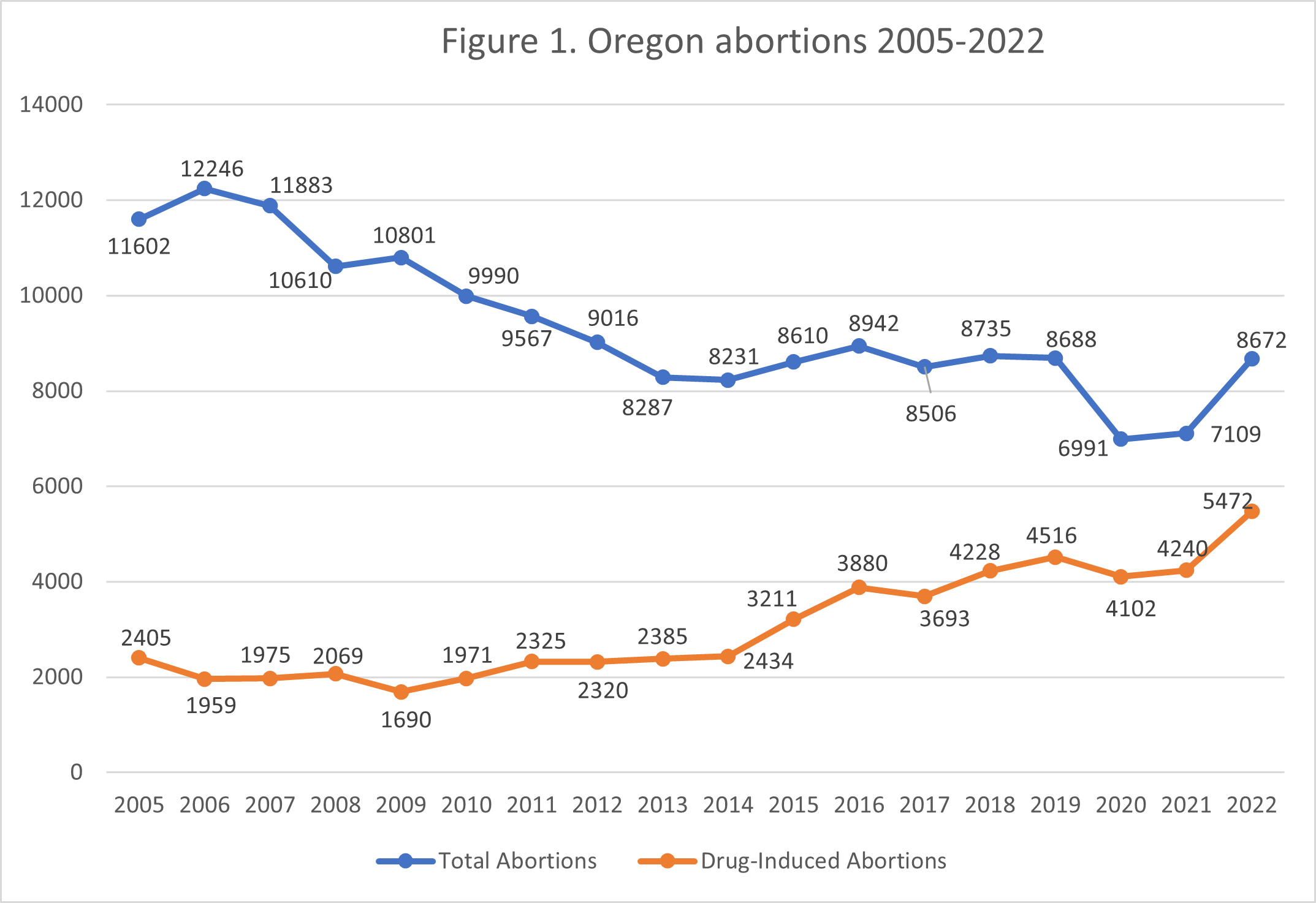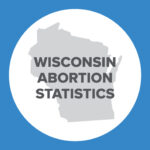Abortion Reporting: Oregon (2022)
Oregon’s 2022 abortion statistics were published in December 2023 on the state’s Induced Abortion Dashboard run by the Oregon Health Authority’s Center for Health Statistics. During 2022, reported abortions in the state increased from 2021. As of February 2024, 34 states had released 2022 abortion statistics, 21 of which showed an increase in abortions from 2021.
Statistics and Changes in Oregon Abortions, 2021-2022

The report does not include information on Planned Parenthood’s Oregon abortion market share.
Abortion Totals and Trends
A total of 8,672 abortions were reported in Oregon in 2022, an increase of 22% from 2021. There were 5,472 drug-induced abortions in 2022, constituting 63% of the total and an increase of 29% from 2021 (Fig. 1). The abortion rate increased 22% from 8.5 abortions per 1,000 resident women in 2021 to 10.4 in 2022 (Fig. 2).1
State Report Summary
In 2022, 88% of the abortions reported in Oregon were performed on state residents. Twelve percent of the abortions (1,036) were performed on nonresident women, with the number increasing by almost half from 2021 when there were 695 abortions performed on nonresidents. The total number of abortions in the state includes 172 telehealth abortions including those from licensed providers located out-of-state, a 112% increase from 2021 when 81 telehealth abortions occurred.
Ten percent of the abortions were performed on girls ages 19 or younger, including 12 abortions on girls less than 15 years old (0.1% of the total number of abortions). Fifty-six percent of Oregon abortions were obtained by women in their twenties, 29% by women in their thirties, and 4% by women ages 40 or older. A majority of women who obtained abortions in Oregon in 2022 had a high school diploma or a GED equivalent (with 27% having this as their highest level of educational attainment), while 21% attended some college but did not obtain a degree. Eleven percent of women had a bachelor’s degree, 8% attended some high school but did not obtain a diploma, 6% had an associate degree, and 3% had a master’s degree. One percent of women who received abortions in Oregon had an eighth grade education or less and another 1% had a doctorate or other professional degree. The level of education was not known for 21% of women who obtained abortions in Oregon in 2022.
Oregon reports abortions by race, but because more than one race may be selected on the abortion reporting form, the total of the figures for each race are higher than the total number of abortions that occurred in Oregon. Sixty-five percent of abortions were performed on white women, and 9% on Black/African American women. Five percent of abortions were performed on Asian women and 3% and 1%, respectively, on American Indian/Alaska Native and Native Hawaiian/Pacific Islander women. Nine percent of women who obtained abortions in 2022 reported their race as “other,” and race was unreported for 10% of the abortions. The Charlotte Lozier Institute (CLI) estimates that the black abortion rate (35.7 abortions per 1,000 women ages 15 to 44) was over four times higher than the white abortion rate (8.1).
Sixteen percent of the abortions reported in Oregon were performed on women who were married, separated, or in a domestic partnership. Sixty-five percent were performed on unmarried women. Marital status was unknown for 19% of the women. Fifty-four percent had no living children, 20% had one living child, and 26% had two or more living children. A majority of abortions were performed on women who had never had an abortion (65%). Twenty percent had one prior abortion, and 13% had more than one.
Thirty-one percent of the abortions occurring in Oregon were performed on women who reported using contraception, while 63% were performed on women who were not using any contraception when they became pregnant. Nine percent of the abortions were performed on women who reported using oral contraception and 9% on women who used condoms. Two percent of the abortions were obtained by women who used the rhythm method and another 2% by women who used emergency contraception. One percent of women used contraceptive rings. Two percent of women used multiple contraceptive methods while 6% did not report whether they were using contraception.
Seventy-four percent of reported abortions were performed before nine weeks of gestation, and 16% occurred between nine and 12 weeks. Five percent were performed between 13 and 16 weeks and 3% between 17 and 20 weeks. Eighty-six abortions were performed between 21 and 22 weeks of gestation—more than halfway through pregnancy, and well past the gestational age when babies can feel pain. Eighty-five abortions were performed at 23 weeks or later. The gestational age was not reported for 28 abortions. Oregon has no limits on how late in pregnancy an abortion may be performed.
Abortion-Related Complications
In 2022, abortions at later gestational ages had the highest rates of reported complications.2 Of the abortions performed at nine weeks of gestation or earlier, Oregon reported that 5.1% resulted in complications. Abortions performed between nine and 12 weeks resulted in complications 6.2% of the time. This decreased to 5% for abortions at 13 to 16 weeks and 5.8% for abortions at 17 to 20 weeks. However, 8.1% of the abortions performed between 21 and 22 weeks of gestation led to complications. This increased to 14.1% for abortions at 23 weeks or later. Overall, the risk of abortion complications increases with gestational age.
Retained products was the most common complication, occurring 111 times. There were 61 cases in which the abortion method failed, 28 cases of hemorrhage, 20 cases of infection, five cases of cervical lacerations, and one uterine perforation. One-hundred and twenty-five women experienced multiple complication, an increase of 127% from 2021. There were 119 unspecified complications, accounting for 25% of total complications.
Abortion Centers in the State After the Dobbs Decision
Following the Dobbs decision that reversed Roe v. Wade, abortion remained legal at any point in a woman’s pregnancy in Oregon. Subsequently, Oregon became an abortion destination for out-of-state women from states with life-at-conception laws like Idaho, which borders Oregon. In spring 2023, a new Planned Parenthood “health center” opened in Ontario, Oregon, which is on the border of Idaho. This follows a trend in pro-abortion states of abortion centers opening on the border of pro-life states to draw women from states where abortion is limited to medical emergencies. Oregon, like many other pro-abortion states, passed a shield law in 2023 that prohibits Oregon officials from cooperating with out-of-state investigations involving abortion and prohibits professional licensure consequences. This law also stated that girls under the age of 15 can consent to an abortion without their parents’ consent. The lack of laws in Oregon protecting the unborn and their mothers from the dangerous complications of abortion has contributed to the state’s large increase in abortions in 2022.
State Ranking
Oregon’s abortion reporting tied for 13th place in a 2016 CLI study of abortion reporting that ranked the 50 states, the District of Columbia, and New York City. To improve, Oregon could be more transparent in reporting data it already collects, such as the facilities where abortions take place and de-identified data on previous miscarriages experienced by women who undergo abortions. Oregon could also collect and report information on the methods of payment used to fund abortion, as well as women’s reasons for choosing abortion. Oregon could further require all healthcare providers, including those in emergency rooms, to report any abortion complications they encounter. As Oregon’s complications statistics illustrate, abortions become more dangerous as gestational age increases, and Oregon permits abortion throughout all nine months of pregnancy.


- National rates are calculated using data from the Guttmacher Institute. Oregon’s abortion rate is calculated using the following formula: (all abortions performed on women ages 15-44 and women of unknown age ÷ resident women ages 15-44 [based on most recent population estimates]) x 1,000. Estimates for 2005-2009 are intercensal estimates of the July 1 resident population. Estimates for 2010-2019 are Vintage 2020 postcensal estimates of the July 1 resident population. Estimates for 2020-2022 are Vintage 2022 postcensal estimates of the July 1 resident population. Estimates were produced by the U.S. Census Bureau and the National Center for Health Statistics.
- Statistics on abortion complications reported here represent a minimal number of deaths and complications, as this data is collected in a non-systematic and non-verifiable way. As such, this data cannot be used to calculate either an accurate abortion mortality rate, or an accurate abortion complication rate for the state.

























